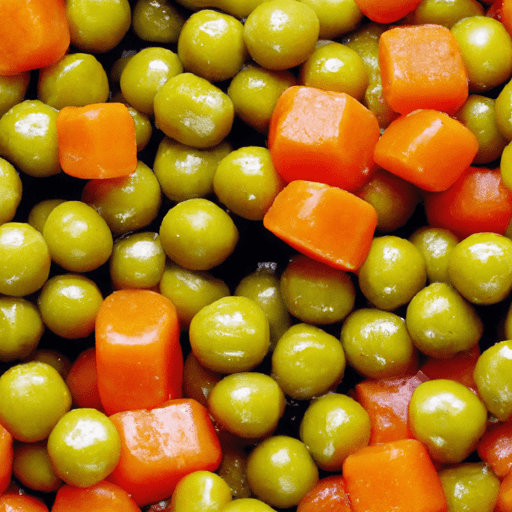Canned Peas and Carrots: The Perfect Duos
When it comes to convenient and versatile vegetables, canned peas and carrots take the spotlight. These little gems, often overlooked in favor of fresh produce, have a lot to offer in terms of taste, nutrition, and ease of use. In this blog post, we will dive into the world of canned peas and carrots, exploring their delightful flavors, various applications in cooking, nutritional value, and even some interesting history and facts.
A Burst of Flavor
Canned peas and carrots bring a burst of vibrant color and complementary flavors to any dish. The bright green peas and tender orange carrots provide a visually pleasing contrast, making them perfect for adding visual appeal to your meals. The peas have a mild and slightly sweet taste, while the carrots offer a delicate balance of sweetness and earthiness. Together, they create a harmonious combination that pleases both the eye and the palate.
Versatile Uses in Cooking
One of the greatest advantages of using canned peas and carrots is their versatility in the kitchen. They can be utilized in countless recipes, adding depth and texture to a wide range of dishes. Here are a few common uses:
- Stir-Fries and Sautes: Add a handful of canned peas and carrots to your stir-fries or sautes to bring a burst of color and flavor. They cook quickly and maintain their fabulous texture, making them an excellent addition to Asian-inspired dishes.
- Soups and Stews: Canned peas and carrots are perfect for enriching the flavor and nutritional content of your soups and stews. Their tender texture blends seamlessly with other ingredients, infusing your beloved comfort foods with wholesome goodness.
- Casseroles and Bakes: Whether you’re preparing a hearty casserole or a flavorful bake, canned peas and carrots are an ideal ingredient. They lend their pop of color and sweetness, enhancing the overall taste and visual appeal.
Nutritional Powerhouses
Beyond their culinary prowess, canned peas and carrots are also packed with important nutrients. Peas are an excellent source of dietary fiber, protein, and vitamins A, C, and K. Carrots, on the other hand, are rich in beta-carotene, vitamin K, potassium, and fiber. Together, they provide a wholesome combination of vitamins, minerals, and antioxidants that support overall health and well-being.
Additionally, the canning process retains much of their nutritional value, ensuring that you’re obtaining these essential nutrients year-round, even when fresh produce may be less accessible.
Interesting History and Facts
Did you know that both peas and carrots have intriguing historical significance? Carrots have been cultivated for over 5,000 years and were initially grown for their aromatic leaves rather than the edible roots we associate them with today. Peas, on the other hand, have a rich history that can be traced back to ancient civilizations such as Egypt and Rome.
It wasn’t until the late 17th century that carrots as we know them today, with their vibrant orange hue, were developed in the Netherlands. Similarly, the widespread popularity of canned peas gained momentum during the late 19th century, as the canning process became more efficient.
Conclusion
Canned peas and carrots are the unsung heroes of the canned vegetable aisle. Their pleasing flavors, versatility in cooking, nutritional benefits, and intriguing history make them a valuable addition to any pantry. So, next time you’re in need of a quick and nutritious addition to your meal, don’t overlook the humble canned peas and carrots - they’re here to bring color, flavor, and convenience to your plate.
Canned Peas and Carrots
Origin and History:
- Peas (Pisum sativum) are believed to have originated in the Mediterranean region and have been cultivated for thousands of years. Carrots (Daucus carota) have their origins in Central Asia and have been domesticated for over 2,000 years.
- Canning, as a preservation method, became widespread in the late 18th and early 19th centuries. The first commercial canning of peas and carrots began in the early 1900s.
Common Uses:
- Canned peas and carrots are a convenient option for cooking and can be used in a variety of dishes, including stews, soups, casseroles, and stir-fries.
- They are often used as a side dish or a component in mixed vegetable medleys.
- Canned peas and carrots can also be used in baby food preparations.
Nutritional Benefits:
- Peas are a good source of dietary fiber, vitamins (including vitamin C and vitamin K), and minerals (such as iron and manganese).
- Carrots are known for their high content of beta-carotene, a precursor to vitamin A. They also contain fiber, vitamins (including vitamin K and vitamin C), and minerals (such as potassium and manganese).
- Canned peas and carrots retain much of their original nutrition, although some nutrients may be lost during the canning process.
Unique Properties and Significance:
- The canning process helps preserve the vibrant color and texture of peas and carrots, making them available year-round.
- Canned peas and carrots have a long shelf life, allowing for easy storage and use when fresh produce may not be readily available.
- While fresh peas and carrots are often preferred for their flavor and texture, canned varieties offer a convenient option for quick and easy meal preparation.
It’s important to note that while canned peas and carrots have their advantages, involving a longer cooking time in the canning process can affect their texture and taste compared to fresh counterparts.




Use the share button below if you liked it.
It makes me smile, when I see it.